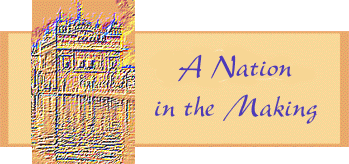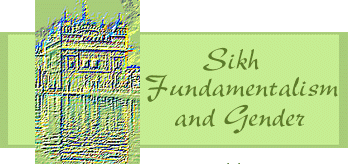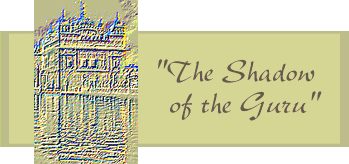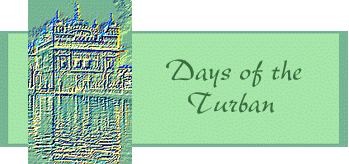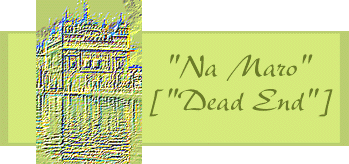Copyright © 2000 by Harveen Sachdeva Mann, all rights reserved. This text may be used and shared in accordance with the fair-use provisions of U.S. Copyright law, and it may be archived and redistributed in electronic form, provided that the editors are notified and no fee is charged for access. Archiving, redistribution, or republication of this text on other terms, in any medium, requires the notification of the journal and consent of the author.
For an examination of the political turmoil in Punjab, see Rajiv Kapur's Sikh Separatism: The Politics of Faith (London: Allen and Unwin, 1986), Robin Jeffrey's What's Happening to India? Punjab, Ethnic Conflict and the Test for Federalism (New York: Holmes and Meier, 1994), and Joyce J. M. Pettigrew's The Sikhs of the Punjab: Unheard Voices of State and Guerrilla Violence (London: Zed, 1995). Key texts dealing with the violent history of Kashmir include Alastair Lamb's Birth of a Tragedy: Kashmir 1947 (Karachi: Oxford UP, 1994), Sumit Ganguly's The Crisis in Kashmir: Portents of War, Hopes of Peace (Cambridge: Cambridge UP, 1997), and Sumantra Bose's The Challenge in Kashmir: Democracy, Self-Determination, and a Just Peace (Thousand Oaks CA: Sage, 1997); while Ajoy Roy's The Bodo Imbroglio (Guwahati: Spectrum Publications, 1995), Chandana Battacharjee's Ethnicity and Autonomy Movement: The Case of the Bodo-Kacharis of Assam (New Delhi: Vikas, 1996), and Maya Chadda's Ethnicity, Security, and Separatism in India (New York: Columbia UP, 1997) investigate the ethnic conflict in Assam. Pan-Indian studies of recent religious/ethnic nationalist upheavals include, among others, M. J. Akbar's Riot after Riot: Reports on Caste and Communal Violence in India (New Delhi: Penguin, 1988), A. Bonner's Averting the Apocalypse: Social Movements in India Today (Durham NC: Duke UP, 1990), Ainslie T. Embree's Utopias in Conflict: Religion and Nationalism in Modern India (Berkeley: U of California P, 1990), and Paul R. Brass's The New Cambridge History of India: The Politics of India since Independence (Cambridge: Cambridge UP, 1994). Back
Hindutva ideology, committed to converting India into a strict Hindu theocracy, Ramrajya, has been in existence since the 1920s with the formation of the Hindu Mahasabha and the Rashtriya Swayamsevak Sangh (RSS); it proliferated in the 1980s, abetted especially by the Vishwa Hindu Parishad (an organization founded in 1964) and more militaristic groups like the Shiv Sena, Arya Vir Dal, and the Bajarang Dal; and in the 1996 and 1998 general elections, the Hindu nationalist party, the Bharatiya Janata Party (BJP), established itself as the largest parliamentary party in the Lok Sabha (the Lower House) and led a coalition national government. As India headed to general elections again in late 1999, the BJP, attempting once more to win an electoral majority, tried to distance itself from its Hindu fundamentalist past in order to gain greater mass appeal. But even after the elections, as Atal Behari Vajpayee was again sworn in as Prime Minister, this time as the head of the Nationalist Democratic Alliance, questions regarding the credibility of the party's ideological shift toward a greater secularism remain: as historian Bipan Chandra noted sceptically in 1998, "Anyone who asks if the BJP is changing should phrase it differently. Since it is the political wing of the RSS, is the mother organisation changing? Why don't you attend an RSS shaka (camp) and hear what they preach there?" (16). As political correspondents Sumit Mitra and Harinder Baweja point out, the RSS, "with its Taliban-like adherence to [essentialist Hindu] ideology," continues to retain its position as the "high command" of the BJP (16, 12); and as political journalist Sutapa Mukherjee confirms about the latest elections, "[W]hatever the BJP may say, it is still seen as the principal adversary by the minorities" ("Minorities Undecided, yet Decisive"). It is imperative, then, that we be alert to the continuing threat of right-wing ideology in India, not only on the part of the BJP but other national and regional parties as well: for example, unsuccessful in the last three elections in its bid to form a national government, the Congress (I), currently opposed to the BJP, has in the past played to Hindu nationalist sentiment, as evidenced by its abetment of the massacres of Sikhs following Indira Gandhi's assassination by two of her Sikh bodyguards in 1984; and many of the regional parties making up the United Front in 1996 and entering into a coalition with the BJP in 1998 and 1999 were/are, in many cases, themselves communally motivated.
Although a detailed examination of Hindu fundamentalism -- as well as its similarities to and differences from Sikh fundamentalism -- is not my primary focus, the early sections of my article do discuss the unambiguous implication of Hindu nationalist ideology in the rise of a reactive Sikh fundamentalism. For more detailed exegeses of modern-day Hindu fundamentalism, especially in its majoritarian backlash to (what its architects perceive/manipulate as) the "threats" of such minorities as the Muslims, Sikhs, and Christians, see Walter K. Anderson and Sridhar D. Damle, The Brotherhood in Saffron: The Rashtriya Swayamsevak Sangh and Hindu Revivalism (Boulder, CO: Westview Press, 1987); Bipan Chandra, Essays on Contemporary India (Delhi: Har-Anand, 1993); Peter van der Veer, Religious Nationalism: Hindus and Muslims in India (Delhi: Oxford UP, 1994); Paul R. Brass, The Politics of India since Independence; Tanika Sarkar and Urvashi Butalia, Women and Right-Wing Movements: Indian Experiences (New Delhi: Kali for Women, 1995); and Arun Shourie, Harvesting Our Souls (Delhi: ASA, 1999). Back
For contrasting views on the use of the controversial term "fundamentalist" to describe recent Punjab separatists, see Harjot Oberoi, 257-59, and John Stratton Hawley, 33. The former defends his usage on three grounds as follows:
First, in the Punjabi word mulvad, Sikhs possess a term that exactly corresponds to fundamentalism and stands in stark opposition to adharma, a Punjabi word for secularism. Although the term mulvad is of recent coinage, resulting from the need to have a Punjabi counterpart to fundamentalism, Sikh journalists, essayists, and politicians, in discussing contemporary religious and political movements, now constantly use the term mulvad, connoting a polity and society organized on the basis of religious (particularly scriptural) authority. . . . Second, there are strong cultural reasons for adopting the term "Sikh fundamentalism." . . . Sikh fundamentalists have no patience for hermeneutic or critical readings of Sikh scriptures. Their scriptural absolutism precludes any secular or rational interpretation of what they consider to be a revealed text. . . . Third, the current Sikh movement . . . amply manifests many tendencies like millenarianism, a prophetic vision, puritanism, and antipluralism, trends that have been commonly associated with fundamentalism. For these three reasons - linguistic, cultural, and associative -- I think we are justified in speaking and thinking in terms of Sikh fundamentalism. (257-58)
Picking up on Oberoi's admission that the term mulvad is "of recent coinage," Hawley, however, argues that
[t]he word bears . . . [a] derivative stamp, and it has for this reason been questioned as a proper analogue to fundamentalism by other scholars of Sikhism such as Gurinder Singh Mann. Mann notes that the term mulvad is very infrequent in current usage, being confined apparently to leftist journals and almost never being used in more general contexts such as newspapers; certainly religious militants would never so characterize themselves (Mann, personal communication, January 29, 1991). (qtd. in Hawley, n. 33, 39)
Further, and most importantly, we must remember to distinguish between fundamentalism and orthodoxy, as T. N. Madan points out:
In the judgment of the government, largely shared by the public (including many Sikhs), Bhindranwale was a fundamentalist. In contemporary political discourse in India, a "fundamentalist" is a person who resorts to selective retrieval, picking out from his religious tradition certain elements of high symbolic significance with a view to mobilizing his coreligionists for action. The goals of such action are usually a mixture of religious objectives (pursuit and propagation of the traditional way of life and of the Truth as stated by the proponents) and the politico-economic interests of one's community as against those of similarly defined other communities. The government, too, is opposed if it comes in the way. Fundamentalists are seen by their critics as closely associated with, or as being themselves, political "extremists" (those who press communal or regional demands against the state so hard as to constitute a threat to political stability) and in certain situations with "terrorists" (those who use different forms of terror, including murder, to further political ends). In Punjab, Bhindranwale had himself been charged twice with complicity in political murders but had not been prosecuted. The fundamentalist is very much a creature of his situation rather than a pure traditionalist, and fundamentalism is not pristine orthodoxy. Orthodoxy would in fact discourage fundamentalism: if the teachings of the [Sikh] gurus are our guide, they advocate catholicity and not narrowness of the mind. (596; emphasis added)
In my article, I generally subscribe to Madan's definition of a fundamentalist/fundamentalism. Back
That women, especially the RSS women's wing revivalists Sadhvi Rithambara and Uma Bharati, have also played extremely reactionary roles in the contemporary communal unrest in India is undeniable as well. And while a consideration of such unorthodox gender positioning vis-à-vis ethnic/religious violence is beyond the scope of my article, I point the reader to such critical analyses as Sucheta Mazumdar, "Women on the March: Right-wing Mobilization in Contemporary India," Feminist Review 49.1 (1995): 1-28; Sudhir Kakar; Tanika Sarkar and Urvashi Butalia. See also note 30 of this essay. Back
I place such descriptors as "the Punjab situation," "the Punjab crisis," and "the Punjab case" in quotation marks to underline their problematic usage as they reduce the very real tragedy afflicting thousands of Punjabis to an abstraction and simplify the enormously complicated politics of Sikh (sub)nationalism. Back
I part company with Naipaul, however, in his unusually sanguine conclusion that such movements strengthen the Indian state -- the workings of government as differentiated from the constitutional "imagining" of the nation -- by "defining it as the source of law and civility and reasonableness." As the Indian Union "gave people a second chance, calling them back from the[ir] excesses," Naipaul holds, the "mutinies" augmented the "strength of the general intellectual life, and the wholeness and humanism of the values to which all Indians now felt they could appeal" (518). On the contrary, the notion of the nation as the "source of law and civility and reasonableness" was/is severely undermined by the government-abetted repressions and atrocities aimed at quashing such "mutinies": for example, the number of people who died in the "encounters" between the "terrorists" and the government in Punjab alone -- conservatively estimated at 25,000 in 10 years (1984-1994) -- hardly points to the "humanism" of the Indian nation or to the "law and civility and reasonableness" of either the loyalists or the militant separatists.
In an incisive review of India: A Million Mutinies Now, Akeel Bilgrami similarly criticizes what he regards as Naipaul's "indiscriminate optimism" regarding modern Indian nationalism and assigns the "tragedy" of the Sikhs to the "tragedy of the failure of federal rule." Distinguishing between a centrifugal -- largely Hindu-religious -- and a centripetal -- largely regional-ethnic -- nationalist sentiment in contemporary India, he too underlines the necessity of a "redefinition of [Indian national] unity," a redefinition that should be grounded in the recognition of differences, whether of caste, class, region, religion, language, or gender:
The idea of the Indian nation, which has never been as precarious as it is now, needs such a redefinition of the process by which unity can be retained. The federal unity that will emerge from diverse coexisting cultural traditions without inegalitarian social formations is far more likely to pull India out of the present crisis of nationhood than a mythical unity with caste inequalities at its very core. And such a redefinition of unity will . . . allow for a framework of central government that readily concedes cultural and political autonomy to the regions. In India's tense mixture of secessionist and unificationist sentiments, in other words, such a redefinition of unity will pre-empt the secessionist threat. (34) Back
The quotation marks are Chatterjee's to mark his borrowing of the term from Benedict Anderson. (See the latter's Imagined Communitites: Reflections on the Origin and Spread of Nationalism [London: Verso, 1983]). But even as he references Anderson's theorizing and usage of the term, Chatterjee also criticizes the Eurocentric bias of his conceptualization of the nation and nationalism (5). Back
Underlining the (potential) disjuncture between the equality promised to all citizens under the Indian constitution and the real, differential protection afforded along caste, religious, and regional lines, Dr. B. R. Ambedkar, the untouchable leader who drafted the constitution, noted presciently,
"On 26 January, 1950 [India's Republic Day], we are going to enter into a life of contradictions. In politics we shall have equality and in social and economic life we will have inequality. . . . We must remove this contradiction at the earliest possible moment or else those who suffer from inequality will blow up the structure of political democracy which we have so laboriously built up." (qtd. in Keer 415) Back
In a related comment, writer Amitav Ghosh too forecasts the emergence of new majority-minority coalitions based on new conceptions of national identity, noting that
[w]hat is really at issue is the question of finding a political structure in which diverse groups of people can voice their grievances through democratic means. It seems to me that India is indeed lurching in fits and starts toward finding such a structure. . . . In many ways, the turmoil is a sign of the astonishing energy that India has generated over the last couple of decades. (A19) Back
For a distinction between three types of nationalism in contemporary India -- secular, Hindu, and separatist -- see Ashutosh Varshney's "Contested Meanings: India's National Identity, Hindu Nationalism, and the Politics of Anxiety," Daedalus 122.3 (1993): 227-61. Back
For a discussion of the divisive, even disastrous social and class impact of the 1970s peasant-based, economic "Green Revolution" in Punjab, see Vandana Shiva's The Violence of the Green Revolution: Third World Agriculture, Ecology and Politics (New York: Humanities-Zed, 1991). Joyce Pettigrew specifically traces the link between the economic unrest engendered by the new agricultural policy, which pitted small against wealthy farmers and the central government, and the rise of the Khalistan movement in her book The Sikhs of the Punjab. Back
It should be noted, of course, that there is a great variety and difference of opinion among Sikhs regarding the issue of self-rule and that no one leader, Bhindranwale or other, can claim to speak uniformly for them all. Back
For a study of the linkages between the Khalsa tradition of religio-military brotherhood and recent Sikh fundamentalism, see Angela Dietrich, "The Khalsa Resurrected: Sikh Fundamentalism in the Punjab," in Studies in Religious Fundamentalism, ed. Lionel Caplan (London: Macmillan, 1987), 122-37. Back
For an informative history of Sikhism, see J. S. Grewal's The New Cambridge History of India: The Sikhs of the Punjab (Cambridge: Cambridge UP, 1990). Back
In her feminist analysis of Sikh literature, religious studies scholar Nikki-Guninder Kaur Singh distinguishes between the ascendance accorded to the feminine principle in the Sikh scriptures and the low position occupied by women in modern Punjabi Sikh culture. This she attributes to the "reincubation of [masculinist] Hindu ideology within Sikh exegesis itself": comprising less than two per cent of the Indian population, Sikhs are, according to her, "surrounded and confined by an androcentric society" (253, 255). Back
In 1981, the Akali Dal made a demand to the federal government for a separate personal law for Sikhs as part of its forty-five point charter of demands. Such a customary law would have carried a provision for a widow to marry her husband's brother and a statute to deprive women of the right to divorce and to property, currently guaranteed to them under the Indian consitution, as well as injunctions against women's use of jewelry, cosmetics, and clothing that reveals the body. "All these features," concludes Amrita Chhachhi, "link patriarchal control to newly emerging class interests particularly the need to maintain and keep control over landed property by sections of the Punjab peasantry," as well as over female images and sexuality. The fact that while the central government ignored the secular demands of Punjabi leaders for additional water for irrigation, state territory, and Chandigarh as the capital city, but took the communal demand for a Sikh personal law under consideration, is further proof of the coincidence of religious fundamentalist, capitalist, and patriarchal interests working to the detriment of women's rights (571). Back
The fact that Bhindranwale's masculinist rhetoric appealed to women as well as men can be seen in the acts of the women's wing of one of the extremist Sikh political groups, which harassed Sikh women who were not wearing salwar kameezes, the traditional dress, and which issued a directive that "women who wear saris [considered Hindu, rather than Sikh attire], pluck their eyebrows and put on lipstick will face dire consequences" (qtd. in Chhachhi 576).
Regarding Naipaul's androcentric bias, Rob Nixon notes generally that "just as, in A Turn in the South, black southerners were more likely than white to be spoken for, so in A Million Mutinies Now, even when women's experience is the subject, Naipaul's interlocutors are unremittingly male. They also emerge as mostly urban, middle aged, and middle class" (170). And Fawzia Mustafa writes more specifically about the chapter in A Million Mutinies Now entitled "Women's Era" that
rather than even approaching anything resembling a feminist analysis or an investigation into women's issues, it instead describes a male-edited, and -centered, helpful-hints-and-fables tabloid for lower-class working women to more easily participate in maintaining the status quo. The loose, non-comprehensive survey of publications for women is soon superseded by Naipaul's fascination for The Women's Era's editor, and his ideological contradictions and love of printing. (193) Back
Naipaul rejects the alternative description of the 1857 Mutiny as the First War of Indian Independence, seeing in the latter phrase a revisionist "20th-century view, 20th-century language, and a kind of mimicry, seeking to give to old India something of the socialist dynamism the Russians found in their own history" (351). For this reason, he stays with the historically situated, colonial term "Mutiny," even taking the title of his travel book from it and charting its much evolved and varied nature in the "million mutinies" in India today. For a criticism of the adoption of the term as the governing trope of his travelogue and his expanded and loose use of the appellation to cover "everything from regional secessionist movements . . . to middle-class individuals . . . tinkering with the edges of caste rituals," see Nixon 170-71. Back
Commenting on the lack of analysis and "intellectual substance" in India: A Million Mutinies Now, Akeel Bilgrami declares that Naipaul "does not bother to make much of an effort at diagnosis. Instead he offers a series of detailed interviews with people chosen as typical of some aspiring community or interest group." Especially with reference to contemporary Punjab, "the 'manufactured grievance' and the 'tragedy' of the Sikhs is nowhere evaluated (not even by the Sikhs interviewed) as a grievance manufactured, to a large extent, by the Congress Party high command in New Delhi, nowehere diagnosed as a tragedy of the failure of federal rule" (30, 31). Back
Even though Gulnari's father -- another stereotypical patriarch -- persuades her to commit suicide so that she might protect the honor of her family, besmirched by her having joined the terrorists, her action is also precipitated by her treatment at the hands of the fundamentalists. Back
See, for example, feminist critiques by Karen Blair, Anne Cranny-Francis, Tom Lalli, April Selley, Mary Ann Tetreault, and Clyde Wilcox of the stereotyping of femininity, the oversexualization or demonization of the (limited number of) competent female characters, and the exoticization of women of color in the Star Trek series, both old and new (Karen Blair, "Sex and Star Trek," Science-Fiction Studies 10.2 [1983]: 292-97; Anne Cranny-Francis, "Sexuality and Sex-Role Stereotyping in Star Trek," Science-Fiction Studies 12.3 [1985]: 274-84; Tom Lalli, "Same Sexism, Different Generation," in The Best of TREK # 15, eds. Walter Irwin and G. B. Love [New York: Penguin], 39-67; April Selley, "'I Have Been, and Ever Shall Be, Your Friend': Star Trek, The Deerslayer and the American Romance," Journal of Popular Culture 20.1 [1986]: 89-104; Mary Ann Tetreault, "The Trouble with Star Trek," Minerva 22.1 [1984]: 119-29; and Clyde Wilcox, "To Boldly Return Where Others Have Gone Before: Cultural Change and the Old and New Star Treks," Extrapolation 33.1 [1992]: 88-100). Back
It is this Indian inflection that is responsible for the transformation of the name "Sulu" into the Africanized "Zulu," a moniker that the race-conscious Mrs. "Zulu" loathes. Back
Whereas Jumpy Joshi, the poet character in Rushdie's The Satanic Verses, defines "the real language problem" of the postcolonial writer as one of "how to bend it [Received Standard English], shape it, how to let it be our freedom, how to repossess its poisoned wells, how to master the river of words of time of blood" (281), Rushdie himself writes in his essay "Imaginary Homelands" that the Indian British writer's linguistic struggle reflects "other struggles taking place in the real world, struggles between the cultures within ourselves and the influences at work upon our societies" (Imaginary Homelands 17). Back
See, for example, Richard G. Fox's anthropological study Lions of the Punjab: Culture in the Making (Berkeley: U of California P, 1985). Back
This passage, if taken to be reflective of Chekov's perspective, could point to an undeniable homoerotic desire on his part. Such a reading is further corroborated by Chekov's confessed "cold-bloodedness toward women" (160) and his maintenance of bacherlorhood until his death. Back
The Delhi Riots: Three Days in the Life of a Nation, eds. Uma Chakravarti and Nandita Haksar (New Delhi: Lancer International, 1987); Akas-Punjab: Punjab Dukhant nal Sambhdit Minni Kahanian da Sangrah, pubs. Shiam Sundar Dipti and Shiam Sundar Aggarwal (Kotkapura, India: Minni Prakashan, 1992); Amiya Rao, Aurobindo Ghose, and N. D. Pancholi, Report to the Nation: Truth about Delhi Violence (New Delhi: Citizens for Democracy, 1985); and Amiya Rao, Aurobindo Ghose, Sunil Bhattacharya, Tejinder Ahuja, and N. D. Pancholi, "Operation Bluestar: The Untold Story" (http://khanda.unl.edu/~sikhism/zulm/part2.html; 7 Oct. 1996). Back
Although the effect of such masculinist ideology has been largely to curtail women's rights as well as political participation and activism, rural women who, in particular, made a militant contribution to the Khalistan movement, and urban women who protected their children, the aged, and their homes -- as well as their menfolk -- during the murderous days of October-November 1984 shatter what Madhu Kishwar describes as "people's preconceptions" that "men alone are the defenders of the community and that women are incapable of performing this task" (31). Back
As Madhu Kishwar points out, Sikh males, both men and boys, were killed selectively, perhaps so that their families would be left without earning members, so that their killers would not have to fear retaliation (9), and so that not only the libidinous, hyper-masculine Sikh male aggressor -- stereotypically constructed and perceived as such by the Hindu majority -- but also his entire community would be emasculated. See also note 30 below for additional commentary on the intersections of gender and communal violence. Back
Several critic-theorists, chief among them Gayatri Spivak, have remarked upon the gendered circumscription of women within Indian nationalism, especially as concretized in the iconography of Bharat Mata, Mother India. In her commentary on Mahasweta Devi's story "Stanadayini," Spivak asserts that
the ideological construct "India" is too deeply informed by the goddess-infested reverse sexism of the Hindu majority. As long as there is this hegemonic cultural self-representation of India as a goddess-mother (dissimulating the possibility that this mother is a slave), she will collapse under the burden of the immense expectations that such a self-representation permits. (244)
In a similar strain, Partha Chatterjee points out that
the inverted ideological form of the relation of power between the sexes: the adulation of woman as goddess or as mother . . . is wholly and undeniably a product of the development of a dominant middle-class culture coeval with the era of nationalism. It served to emphasize with all the force of mythological inspiration what had in any case become a dominant characteristic of femininity in the new construct of "woman" standing as a sign for "nation," namely the spiritual qualities of self-sacrifice, benevolence, devotion, religiosity, and so on. . . . In [addition], the image of woman as goddess or mother served to erase her sexuality in the world outside the home. (130-31) Back
Two alternative readings of the marginal or unfavorable roles accorded to the men in "Agli Subah" are possible; both underscore my support of feminist, anti-patriarchal interventions in fundamentalist violence. Sarbjeet can be seen, for example, as a positively feminized male who mounts an effective critique of the fundamentalist, masculinist logic of war, as he wonders,
Is it his fault that Indira Gandhi was murdered by her Sikh guards? Why did the bastards kill her? Why did they become traitors? They had taken an oath to save her life, they had eaten her salt to guard her, and they murdered her with their own hands! And an unarmed woman at that! No just one shot! Sixteen bullets! This is no bravery of a Khalsa. We don't even strike an animal twice. (169)
But a much more unfavorable interpretation of the feminization of the male "enemy" is also current, as psychoanalyst Sudhir Kakar points out in a particularly pertinent example:
Violence between relgious-ethnic groups is, then, also a struggle over the assignment of gender, a way of locating the desired male and denigrated female communitites. As a Hindu patient, echoing the sentiments of a few others, remarked in a session during the 1984 anti-Sikh riots in Delhi: "It serves them right! Every one of these cunts (chutiye) behaves as if his prick is at full mast!" (142)
Such an acutely negative reconfiguration of gender relations also underlies the "logic" that pits self-claimed emasculated Hindu males against stereotypically constructed hyper-masculine Sikhs and "enables" the former to violate the latter, often in ways in which women are degraded. Such a "logic" is voiced in particular by the Hindu Bansal Babu in "Agli Subah": "These people were not going to learn a lesson without a beating. They killed so many Hindus in Punjab, and we kept quiet . . ."; "How can you make excuses for the enemy? If we don't kill them, they will surely erase every trace of Hindus, don't you know that?" and "If they start shooting, will we not set fire? Or should we give them a drink of water, you think? We won't claim to have a name if we don't burn them alive" (167, 170). Paradoxically, it is such a claim of the figurative emasculation of Hindu men by men of minority communities, whether Sikh or Muslim, that created the conditions for Hindu women like Sadhvi Ritambhara and Uma Bharati to join, and even occupy leadership positions in the Hindutva militant community. Back
For a discussion of the larger linkage between male nationalist ideology and the gender-based dichotomy between the spiritual/material realm and the inner/outer, ghar (home) / bahir (world) social space, see Partha Chatterjee 116-34. Just as the early Indian nationalists, citing a need to preserve Indian national culture against the onslaught of British colonialism, confined women to the home and constructed both as "represent[tatives of] one's inner spiritual self, one's true identity" (120), so do modern fundamentalists perpetuate the ideological home/world, female/male dichotomy in the social sphere. It is such a gendered ideology amongst fundamentalist Sikhs specifically and rural Punjab generally that Cour is metaphorizing in her protagonist's enclosure within the bounds of her home. Back
In his dependent status, Cour's male "extremist" can also be regarded as positively feminized like Garg's Sarbjeet. In addition, aware as she is of her power of life or death over him, Cour's protagonist, like Garg's Satto, subscribes to a politics of egalitarianism, treating the "extremist" as a brother and (an equal) human being. Back
It is important as well to note that Pritam invokes the eighteenth-century male poet Waris Shah, author of the Punjabi epic Heer, which tells the tragic story of a young woman who falls victim to the manipulations of a patriarchal society, to enable her to write her modern-day "Book of Love" amidst continuing male violence. Back
Works Cited
- Alexander, Meena. "Foreword: Translating Violence: Reflections after Ayodhya." Blood into Ink. xi-xvii.
- Bhindranwale, Jarnail Singh. "Speech at the Annual Conference of the All India Sikh Students Federation." Trans. Ranbir S. Sandhu. 20 Sept. 1983. http://www.khalistan.org/jarnail.htm (6 June 1997).
- Bilgrami, Akeel. "Cry, the Beloved Subcontinent." The New Republic. 10 June 1991: 30-34.
- Blood Into Ink: South Asian and Middle Eastern Women Write War. Eds. Miriam Cooke and Roshni Rustomji-Kerns. Boulder, CO: Westview P, 1994.
- Chandra, Bipin. India Today. 9 Feb. 1998: 16.
- Chhachhi, Amrita. "The State, Religious Fundamentalism and Women: Trends in South Asia." Economic and Political Weekly. 18 March 1989: 567-78.
- Cour, Ajeet. "Na Maro" ("Dead-end"). Trans. Ajeet Cour. The Slate of Life: An Anthology of Stories by Women. New Delhi: Kali for Women, 1990. 64-83.
- Chatterjee, Partha. The Nation and Its Fragments: Colonial and Postcolonial Histories. Princeton: Princeton UP, 1993.
- Das, Kamala. "The Inheritance." Kamala Das: A Selection with Essays on Her Work. Eds. S. C. Harrex and Vincent O'Sullivan. Adelaide, Australia: Centre for Research in the New Literatures in English, 1986, 63.
- Garg, Mridula. "Agli Subah" ("The Morning After"). Trans. Vidyut Aklujkar. Blood into Ink. 164-74.
- Ghosh, Amitav. "In India, Death and Democracy." New York Times, 26 Nov. 1990. A19.
- Hawley, John Stratton, ed. Fundamentalism and Gender. New York: Oxford UP, 1994.
- Jalandhary, Surjeet. Bhindanwale Sant. Jalandhar, India: Punjab Pocket Books, 1984.
- Jenkins III, Henry. "Star Trek Rerun, Reread, Rewritten: Fan Writing as Textual Poaching." Close Encounters: Film, Feminism, and Science Fiction. Eds. Constance Paley et al. Minneapolis: U of Minnesota P, 1991. 180-89.
- Juergensmeyer, Mark. "The Logic of Religious Violence: The Case of the Punjab." Contributions to Indian Sociology 22.1 (1988): 65-88.
- Jussawalla, Feroza, ed. Conversations with V. S. Naipaul. Jackson: UP of Mississippi, 1997.
- Kakar, Sudhir. The Colors of Violence: Cultural Identities, Religion, and Conflict. Chicago: U of Chicago P, 1996.
- Keer, Dhananjay. Dr. Ambedkar: Life and Mission. Bombay: Popular Prakashan, 1971.
- Kishwar, Madhu. Religion at the Service of Nationalism. Delhi: Oxford UP, 1998.
- Madan, T. N. "The Double-Edged Sword: Fundamentalism and the Sikh Religious Tradition." Fundamentalisms Observed. Eds. Martin E. Marty and R. Scott Appleby. Chicago: U of Chicago P, 1991. 594-627.
- Mitra, Sumit, and Harinder Baweja. "RSS on the Rampage." India Today. 28 Sept. 1998. 12-17.
- Mohanty, Chandra Talpade, and Satya P. Mohanty. "Introduction: Lives of Their Own." The Slate of Life: More Contemporary Stories by Women Writers of India. Ed. Kali for Women. New York: Feminist P, 1994. 1-25.
- Mukherjee, Sutapa. "Minorities Undecided, yet Decisive." Outlook, 17 May 1999. http://www.outlookindia.com/previous/051799/affairsl1.htm
- Mustafa, Fawzia. V. S. Naipaul. New York: Cambridge UP, 1995.
- Naipaul, V. S. India: A Million Mutinies Now. London: Minerva, 1990.
- Nixon, Rob. London Calling: V. S. Naipaul, Postcolonial Mandarin. New York: Oxford UP, 1992.
- Oberoi, Harjot. "Sikh Fundamentalism: Translating History into Theory." Fundamentalisms and the State: Remaking Polities, Economies, and Militance. Eds. Martin E. Marty and R. Scott Appleby. Chicago: U of Chicago P, 1993. 256-85.
- "Operation Bluestar: The Untold Story." Comp. Amiya Rao et al. http://khanda.unl.edu/~sikhism/zulm/part2.html (7 Oct. 1996).
- Paranjpe, Makarand R. "Inside and Outside the Whale: Politics and the New Indian English Novel." The New Indian Novel in English: A Study of the 1980s. Ed. Viney Kirpal. New Delhi: Allied, 1990. 213-26.
- Pettigrew, Joyce. "In Search of a New Kingdom of Lahore." Pacific Affairs 60 (Spring 1987): 1-25.
- Pritam, Amrita. "Waaris Shaah Nuun" ("To Waris Shah"). Trans. Kiron Bajaj and Carol Coppola. Blood into Ink. 14-15.
- Rushdie, Salman. "Chekov and Zulu." East, West. New York: Vintage, 1996. 147-71.
- ---. Imaginary Homelands. New York: Viking, 1991.
- ---. The Satanic Verses. New York: Viking, 1989.
- Shanker, Rajkumari. "Women in Sikhism." Religion and Women. Ed. Arvind Sharma. Albany: SUNY Press, 1994. 183-210.
- Sharma, Partap. Days of the Turban. London: Futura, 1986.
- Singh, Nikki-Guninder Kaur. The Feminine Principle in the Sikh Vision of the Transcendent. Cambridge: Cambridge UP, 1993.
- Spivak, Gayatri Chakravorty. In Other Words: Essays in Cultural Politics. New York: Routledge, 1987.
- Tully, Mark, and Satish Jacob. Amritsar: Mrs. Gandhi's Last Battle. London: Jonathan Cape, 1985.
